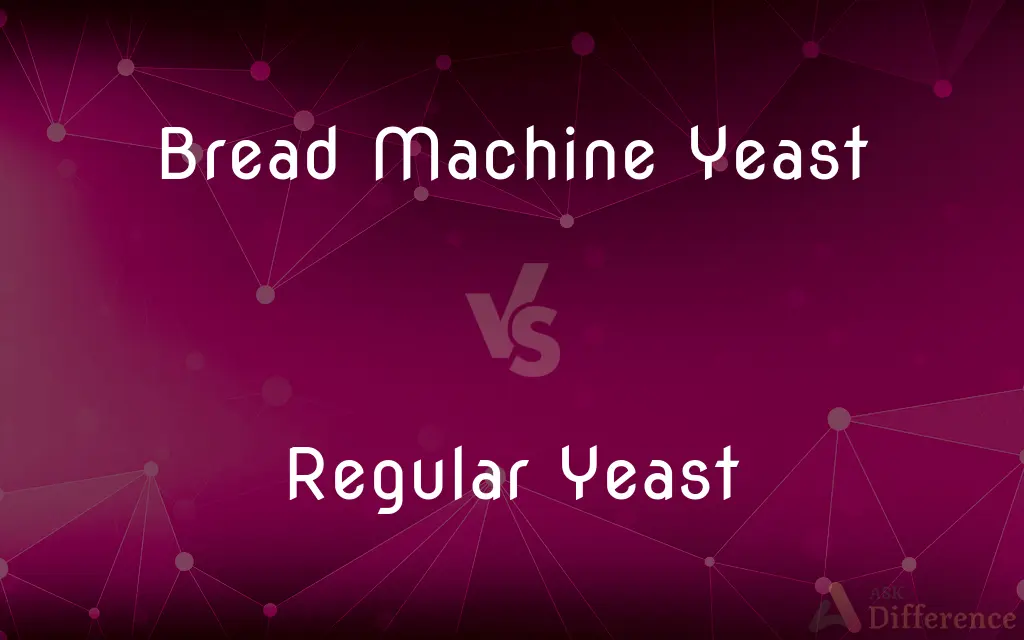Bread Machine Yeast vs. Regular Yeast — What's the Difference?
By Tayyaba Rehman — Published on December 26, 2023
Bread Machine Yeast is optimized for bread makers and rapid-rise, while Regular Yeast is traditional, requiring proofing before use.

Difference Between Bread Machine Yeast and Regular Yeast
Table of Contents
ADVERTISEMENT
Key Differences
Bread Machine Yeast and Regular Yeast both serve the primary purpose of fermenting dough in bread-making processes. Bread Machine Yeast is specially formulated to be used directly in bread machines, eliminating the need for a first rise. On the contrary, Regular Yeast, often called active dry yeast, requires proofing and typically a longer rising time.
Designed for convenience, Bread Machine Yeast caters to the modern baker who might be using automated bread-making appliances. This yeast allows for quicker bread production, often in under an hour. Regular Yeast, while versatile, necessitates a more hands-on approach, including dissolving in water and allowing for a more extended fermentation.
When it comes to granule size, Bread Machine Yeast has finer granules, ensuring that it dissolves faster. Regular Yeast features coarser granules, needing warm water and a bit of sugar for activation. Both types yield the carbon dioxide that makes bread rise, but their usage and timings differ.
While both yeasts can be used interchangeably in many recipes with some adjustments, Bread Machine Yeast's rapid action makes it a preferred choice for bread machines. Regular Yeast, being traditional, offers a slower, more controlled fermentation, often preferred by artisan bakers.
In terms of availability, Bread Machine Yeast is commonly found in supermarkets, tailored for those with bread machines at home. Regular Yeast, with its longstanding history, is a staple in most stores and can be used in a myriad of baking applications beyond just bread.
ADVERTISEMENT
Comparison Chart
Usage Purpose
Optimized for bread machines
Traditional yeast requiring proofing
Rising Time
Rapid-rise, often within an hour
Requires a longer rising time
Granule Size
Finer granules
Coarser granules
Activation
Directly mixed with flour
Needs warm water and sugar for activation
Typical Application
Automated bread-making processes
Traditional and artisan baking
Compare with Definitions
Bread Machine Yeast
Eliminates the need for the first rise.
With Bread Machine Yeast, she skipped the initial proofing.
Regular Yeast
A staple found in most stores' baking aisles.
She restocked her Regular Yeast supply from the local grocery.
Bread Machine Yeast
Contains finer granules for quicker dissolution.
Bread Machine Yeast blended seamlessly into the dough.
Regular Yeast
Features coarser granules than instant variants.
Regular Yeast took a few minutes to dissolve completely.
Bread Machine Yeast
Often found in supermarkets for home bakers.
She picked up Bread Machine Yeast for her new bread maker.
Regular Yeast
Preferred for controlled, slow fermentation.
For her artisan bread, she chose Regular Yeast.
Bread Machine Yeast
Suitable for rapid-rise recipes.
Using Bread Machine Yeast, her loaf was ready in under an hour.
Regular Yeast
Versatile in various baking applications.
Regular Yeast was her go-to for both bread and pastries.
Bread Machine Yeast
Yeast designed for direct use in bread machines.
She used Bread Machine Yeast for the express baking cycle.
Regular Yeast
Traditional yeast requiring activation before use.
She proofed the Regular Yeast in warm water.
Common Curiosities
Can I use Bread Machine Yeast in a traditional recipe?
Yes, but you may need to adjust rising times and skip initial proofing.
Is Regular Yeast the same as active dry yeast?
Yes, Regular Yeast often refers to active dry yeast.
Which yeast gives a more robust flavor?
Regular Yeast, due to its slower fermentation, can often impart a deeper flavor.
Can Regular Yeast be used in a bread machine?
Yes, with adjustments to the recipe and possibly a longer rise time.
How should I store opened Regular Yeast?
Store in an airtight container in the refrigerator.
Can I interchange the yeasts in recipes?
With adjustments to proofing and rise times, they can often be interchanged.
Does Bread Machine Yeast need sugar to activate?
No, it can be directly mixed with flour.
Why is Bread Machine Yeast more rapid?
It's formulated for quick dissolution and rapid fermentation.
Do both yeasts have the same shelf life?
Generally, yes, but always check expiration dates and store in a cool, dry place.
Is there a difference in price between the two?
Prices vary, but Bread Machine Yeast might be slightly more expensive due to its specialized nature.
Which yeast is better for a beginner baker?
Bread Machine Yeast is more forgiving and easier for beginners, especially with bread machines.
Is Bread Machine Yeast the same as instant yeast?
They're similar, but Bread Machine Yeast is specifically optimized for bread makers.
How do I activate Regular Yeast?
Dissolve in warm water (around 110°F) with a pinch of sugar.
How do I know if my Regular Yeast is still active?
Proof in warm water; if it becomes frothy in 10 minutes, it's active.
Do both yeasts work with whole grain flours?
Yes, but rise times and yeast amounts might need adjustments.
Share Your Discovery

Previous Comparison
Legislative Assembly vs. Legislative Council
Next Comparison
Original DVD vs. Pirated DVDAuthor Spotlight
Written by
Tayyaba RehmanTayyaba Rehman is a distinguished writer, currently serving as a primary contributor to askdifference.com. As a researcher in semantics and etymology, Tayyaba's passion for the complexity of languages and their distinctions has found a perfect home on the platform. Tayyaba delves into the intricacies of language, distinguishing between commonly confused words and phrases, thereby providing clarity for readers worldwide.












































